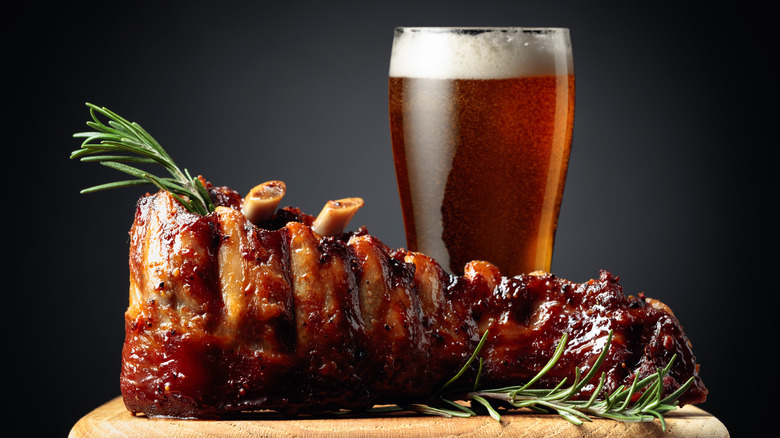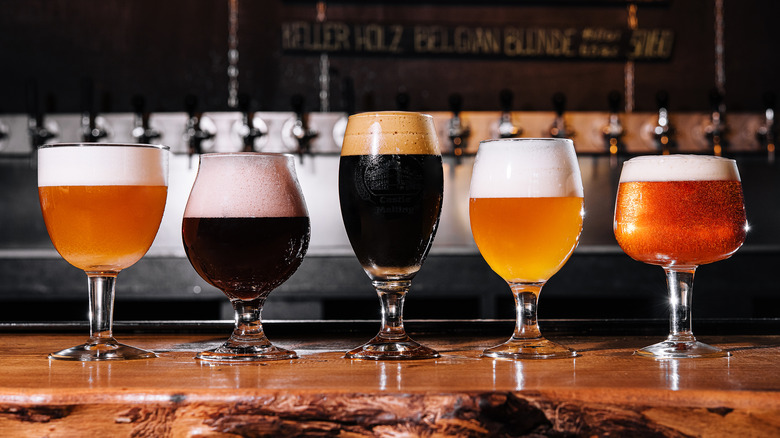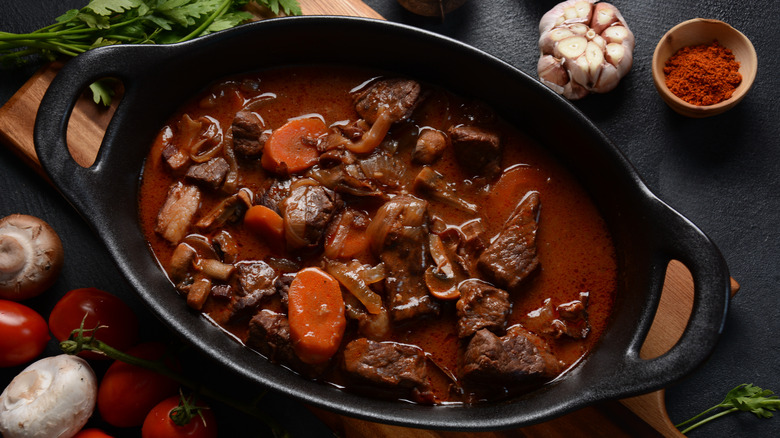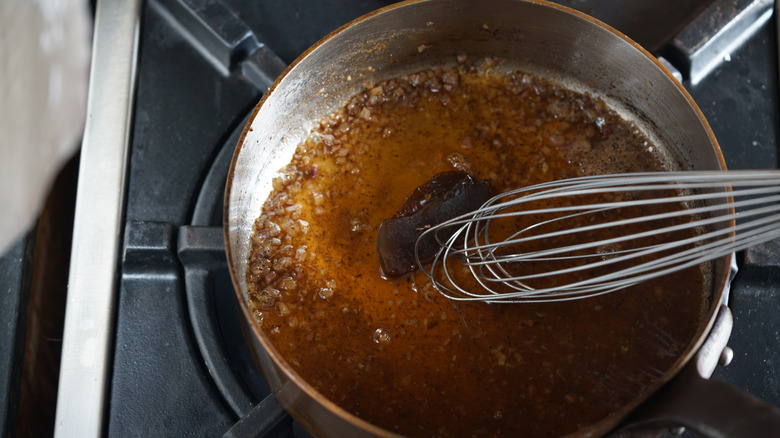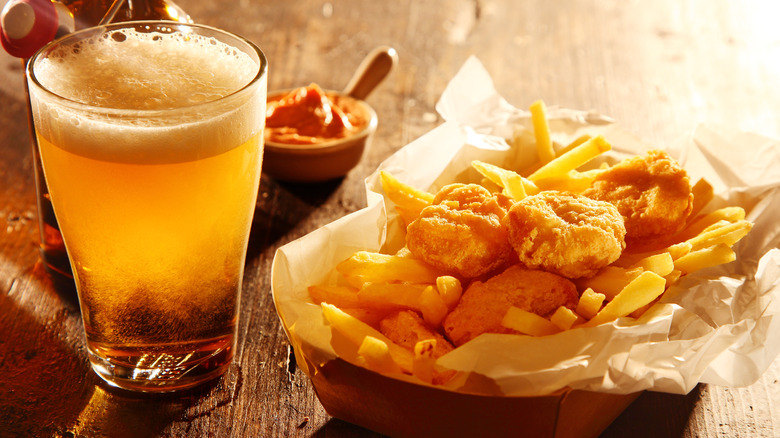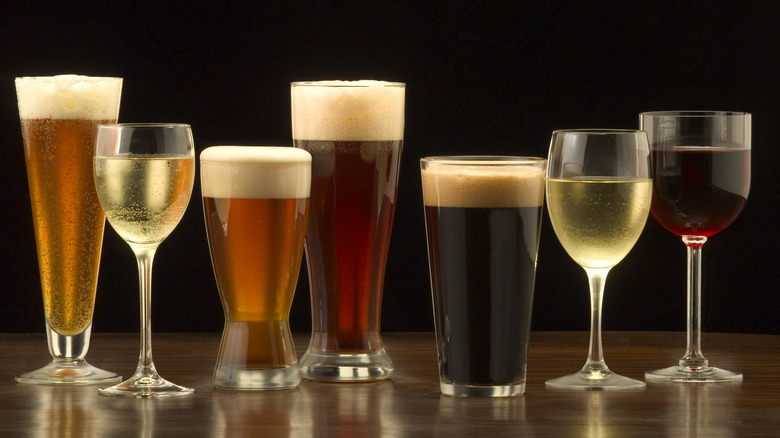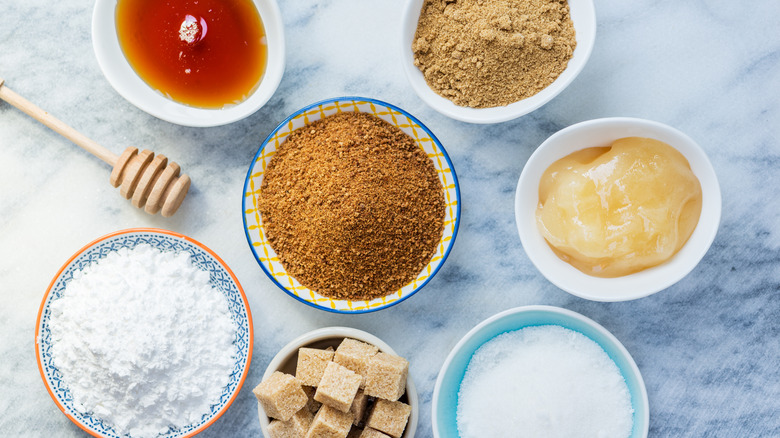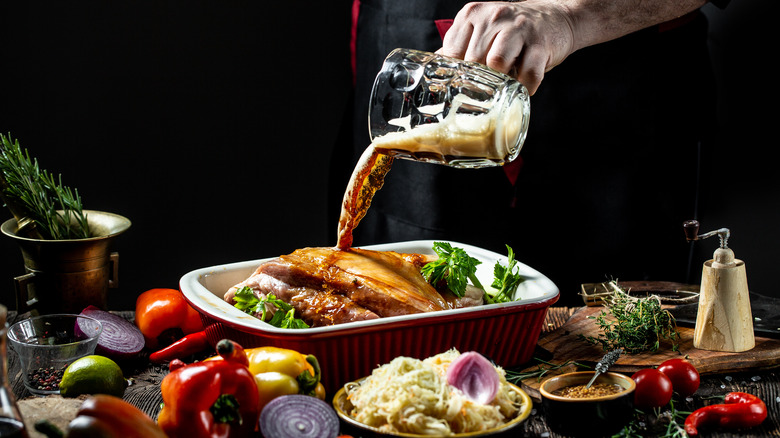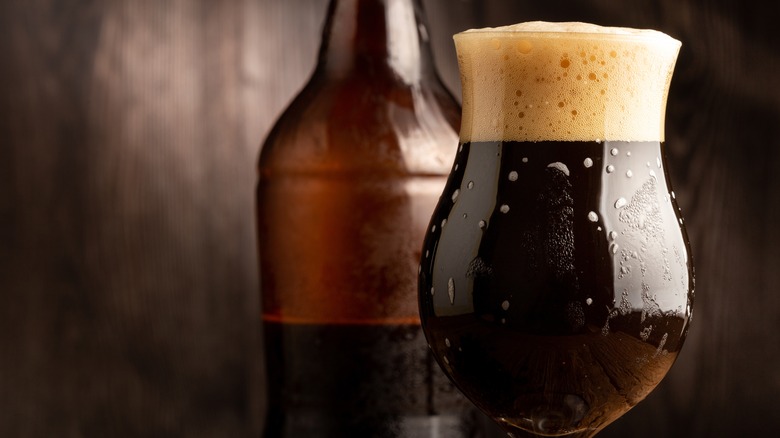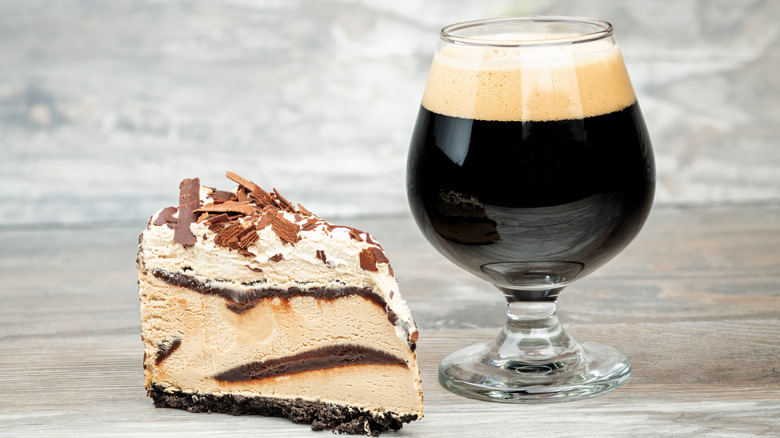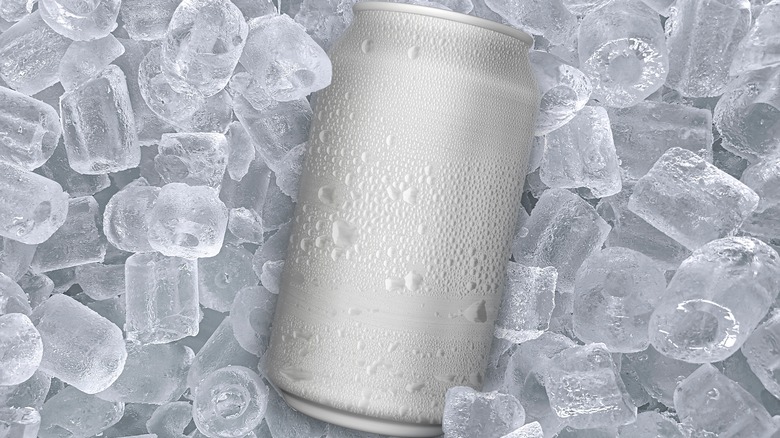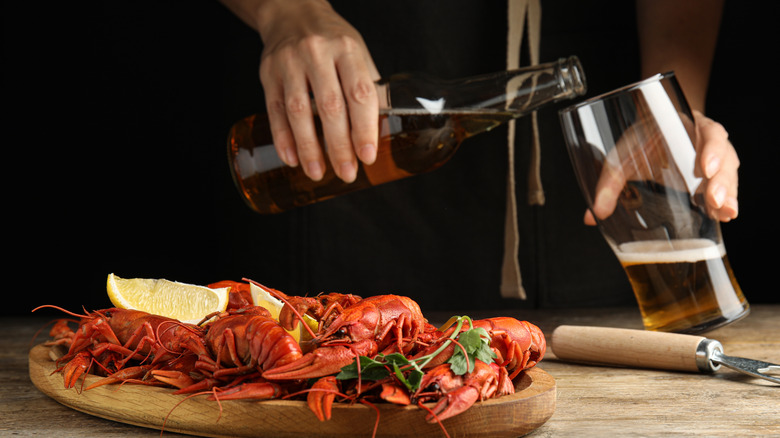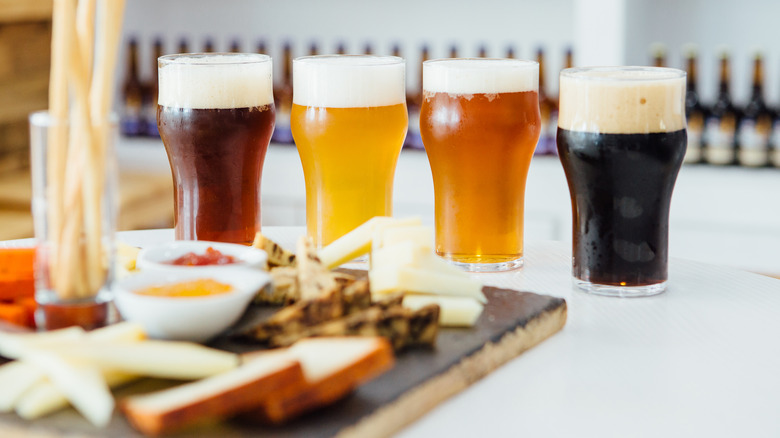Useful Tips On How To Cook With Beer
Cooking with beer is not just a recent fad. Countries with rich brewing traditions have long incorporated this bubbly brew in recipes to give dishes more character and flavor. The practice of cooking with beer has undoubtedly benefited from the massive array of styles that were reintroduced and perfected during the craft beer boom as well.
Using beer in the kitchen opens a new world of opportunities and flavor combinations. Beer is perhaps the most versatile alcoholic drink for cooking. It blends into sweet and savory dishes — this flavor-packed beverage has seemingly endless potential. Its effervescence adds lightness to batters and dough, while its flavor can be a huge game-changer in marinades, sauces, condiments, and creamy frostings.
Although the sheer number of varieties and styles can be intimidating for novice beer cooks, in reality, cooking with beer is relatively straightforward and can lead to more exciting and better-tasting dishes. To encourage more beer-infused endeavors in the kitchen, we've rounded up essential tips that will make cooking with beer hassle-free and utterly enjoyable.
Not all beer styles are created equal
The most important step when cooking with beer is to get familiar with all the different types of beer. The styles are mainly dictated by the brewing technique and the selection of hops and malt, which greatly influence the final characteristics of the beer, including its flavor, carbonation, color, and alcohol content. Naturally, this means that not all beer will perform the same in cooking and that you can't swap a specific style called for in a recipe with whatever you have on hand. There is no singular all-rounder style that is considered ideal for cooking. The final selection mainly depends on the flavor you want in your dish.
The best advice is to pair similar characteristics and flavors. If you are making a rich and beefy beer-infused stew, you want to use a style with a dark, rich character, such as classic Irish stout or Belgian Trappist beer. For lighter dishes where poultry and seafood take central stage, opt for more approachable styles such as wheat beer or amber ale. Try classic lagers or pilsners in batters or dishes that call for higher effervescence and muted, subtle flavors.
Mild pale ale is perhaps the most versatile option for cooking. It incorporates well into hearty and robust dishes but is not too harsh for more nuanced recipes. Because of their distinctive hop character and piercing bitterness, IPAs are generally not recommended for cooking.
Beer is a great braising liquid
If you are looking for an easy way to incorporate beer into your regular cooking routine, it is best to start with braises. Classic braises usually call for a small amount of liquid and some type of protein — in most cases, tougher and less expensive cuts of meat that have tons of flavor but require some time in the oven. Along with broth, braises will often include wine, and though you can never go wrong with this traditional combination, swapping wine with beer will give the dish a completely different flavor dimension.
When deciding on the beer style for a braise, the foolproof technique is to look for flavors you want in your finished dish. Generally, braises will call for beers with more character and intensity. For a beef braise, you want darker beers with plenty of malty sweetness and complex flavors such as porters or stouts. Both styles will impart toasty, nutty, chocolate, and cocoa notes. For lighter dishes incorporating pork, poultry, beans, and veggies, use more subdued brews such as brown ales. As the long and slow cooking technique significantly concentrates flavors, you don't want anything excessively bitter or sour to clash with the flavor profile dominated by savory, toasty, and earthy elements.
It's great for deglazing
Deglazing is a cooking technique in which you add liquid directly to the sizzling pan you just used to sear or sautee food. As the liquid contacts the pan, all the bits and pieces glued to the bottom loosen up, and you can easily scrape them and blend them into a sauce. These tiny food specks don't look like much, but they are packed with caramelized flavor that will elevate any dish.
Deglazing works with any liquid — even a splash of water — but it's best to use flavorful liquids. Wine is an excellent classic alcohol for deglazing, but a splash of beer would make a fantastic alternative to attain more roasted notes, malty sweetness, and caramel flavors.
Beer can be used in most dishes where you would use wine for deglazing. It is great for pan sauces, stews, or braises. You can quickly deglaze and make a sauce in a couple of minutes, but if you want those beer flavors to concentrate and become more pronounced, you can slowly reduce your liquid on heat. In the latter case, choosing a beer that is not overly hoppy and bitter is essential, as the bitterness will also amp up with cooking. Ideally, you want to deglaze with beer whenever you work with a heavier and more robust protein — think of steaks, stews, and lamb or beef braises.
Use beer any time you need lightness in your bread, cakes, and batters
The main reason beer should appear in your kitchen is the beautiful depth of flavor it can transmit into the dish. However, don't forget that this fizzy drink can also significantly impact the texture and consistency of baked goods.
Though people tend to ignore it in baking and mainly limit its use to savory dishes, beer is an ideal addition to cakes, cookies, and quickbreads. Most of these products call for some leavening action, and though beer cannot be single-handedly responsible for making bread and cakes rise, it can help in the process due to its carbonation. Essentially, adding beer gives your baked goods a better chance for a more delicate, tender texture. Of course, any beer you use will lend flavor as well, resulting in a more complex and overall better-tasting dish.
Apart from baking, the effervescence in beer is an excellent aid in fried batters. Classic beer batter is a well-known and commonly used formula that creates a crunchy and airy coating when deep-fried. The main reason is that the air-filled pockets in the batter puff up during frying, creating a wonderfully light, crispy texture. Additionally, carbonation creates an acidic environment where gluten does not form easily and thus doesn't make the firm bonds that result in a chewy coating.
In some recipes, beer can be a great replacement for wine or other liquids
If you want to implement more beer into your cooking, the easiest tip is to use it instead of the liquid suggested in the recipe. In many cases, beer can be an excellent replacement for wine, water, and stock. Simply replace them with the same amount of beer and give the dish the required moisture.
Swapping bland, flavorless water with beer is particularly interesting, as the dish will profit from a potent flavor boost. Though broth and stocks are considerably more flavorful than water, beer still has a more nuanced, complex, and varied character. Wine can compare with beer in terms of intensity, but the two have very different flavor profiles, so make sure to use a beer whose character fits in the recipe and partners well with other ingredients. Of course, this swap will not always be possible, but in most cases, trusting your palate and matching the intensity will lead to a favorable outcome.
In most cases, do not swap beer with fatty liquids such as milk or cream. If you do try it, add extra oil to the mix to compensate for the loss of fat, but this can be rather tricky to pull off successfully.
Use sweetness and acidity to balance out the bitterness
Hop bitterness is usually considered a positive and welcomed quality in beer. You want to get some of those bitter flavors in the brew as it makes beer taste fresh, bold, and powerful. However, when it comes to cooking, this quality is often something you want to avoid.
Cooking will inevitably concentrate the already existing flavors in beer, making them stronger and more pronounced. This is mostly a positive thing, but if bitter flavors become too intense, they have the power to throw a whole recipe out of balance and can easily take over and ruin a dish. That's why beer with a higher IBU — a standardized system measuring beer bitterness — is generally not recommended as a good cooking option.
Luckily, there are easy ways to temper this sometimes unpleasant bitterness. Sugar is the easiest solution. Any sweetness, whether delivered from naturally sweet ingredients or sweeteners like sugar, syrups, or honey, can counteract bitterness. Acidity is another great option to attain some balance. Creamy and fatty elements can also be an excellent solution as the richness helps to tone down the bitterness.
Beer is ideal for marinades
One of the greatest ways to use beer in the kitchen is to add it to marinades. Though the ingredients vary, a standard marinade typically incorporates oil, an acidic ingredient such as wine, aromatics, and a myriad of spices, herbs, and seasonings. You can easily swap wine for beer to create an exceptional marinade. Though it is questionable whether it can help tenderize meat, beer will impart a ton of flavor to the protein. As an added perk, some sugar will remain even after you remove the meat from the marinade, creating a delectable caramelized coating.
It is relatively easy to find the beer style suitable for a marinade that pairs with the meat and other ingredients in your dish. If you are looking for classic choices, you can never go wrong with German wheat beer, which would make an excellent marinade for chicken, or Belgian abbey beers, stouts, and dark ales for beef, pork, or lamb.
Another great thing about a beer marinade is that you can always use it as a starting base for a sauce you will serve with the meat — just bring the marinade to a boil to kill any pathogens that may have been present in the raw meat, per the USDA.
It's best to use room temperature beer
Think of the following tip as a general cooking guideline you can apply when adding any liquid to a dish. You want to be sure to bring your liquid to room temperature, as adding a fridge-cold brew can immediately reduce the temperature of the dish, slowing down the cooking process.
The same rule applies to baking with beer. Unless stated otherwise, you want to work with ingredients that are about room temperature. Adding anything chilled to a lukewarm mix might disrupt the textures and consistency. This is a tip you should always apply when combining beer with yeast. Yeast strains need a warm setting to give baked goods a faster rise and a light, airy texture, and they simply can't perform at the same speed in a cold environment.
You should also open the beer before cooking and let it rest for a while. This period will give the beer time to settle and calm down and not foam up in the dish. However, you don't want to leave it out too long and let it become flat and lose all of its fizziness — a couple of minutes will suffice.
You can use beer in dishes without cooking it out
Though we mainly mentioned beer in the context of cooked dishes, it's not necessary to always cook it out. Beer can be added to dishes in its raw state as part of a dressing or a condiment. By skipping the cooking step, you will get to incorporate the true flavor of the brew that will not change or get masked in the process. This technique allows you to play with tricky styles, such as zesty sours and hop-forward beers, that generally don't work well in cooking.
Beer-based salad dressings can work great. Even a splash of beer will add a mountain of flavor. The style depends on what you want the beer to deliver. If you are aiming for a tart vinaigrette-like dressing, you want to work with a beer that will provide some sharpness, such as a classic Belgian kriek, wheat beer, or citrusy IPA. You always want to include a sweet element here for balance.
Apart from dressings, beer makes a fantastic addition to various condiments. Use it to flavor ketchup, mustard, or mayo — smoked beer would be perfect in BBQ sauce. Finally, remember that you can add beer to frostings or creamy desserts, but make sure to go with something malty and sweet. Use coffee stout for a spin on Italian tiramisu or pair luscious chocolate frosting with richly flavored dark ales.
Freeze any leftover beer
If you avoid cooking with beer because you don't like to drink it and never know what to do with leftovers, this tip offers a solution. Freezing is a great way to save and repurpose nice-tasting beer.
Most beer has a relatively low alcohol content, roughly around 5% ABV. This means that it will be much easier to freeze than other alcohol-laced beverages, but keep in mind that there is some alcohol, so it will take a bit longer to freeze than water. Beer should not be frozen in cans or bottles as it might result in an explosion, so you must repackage it into containers suitable for freezing. Always leave some room in the container so the beer can expand as it freezes.
Freezing and thawing beer should not significantly influence the flavor of the brew. However, the process can greatly diminish the effervescence, which will probably get lost in the process. Frozen and thawed beer will thus probably not be pleasant to drink. Luckily, unless you want to use it in baked goods, for most beer-infused dishes, carbonation is not crucial.
A little goes a long way
Don't go overboard with the amount of beer you plan to add to the dish. It's best to start cautiously with a small quantity, as you can easily add more beer later if you wish to increase the intensity. Keep in mind that you are working with a very flavorful ingredient, and even a small amount will add plenty of depth and complexity.
Remember that any cooking or exposure to heat will enhance and concentrate the flavors already present in beer, so make sure you know how strong-flavored your brew is. Taste and test both before and during the cooking process to ensure the flavors are balanced. Also, don't forget that beer is a liquid, so it can easily disrupt the textural balance if too much is added at once. You don't have to worry too much about the alcohol content, as most of it will evaporate, especially if you use beer in dishes that take some time to cook.
Any beer you used for cooking will be a great pairing with the finished dish
When you've succeeded in creating the perfect beer-infused dish, it's time to serve it and reap the benefits of all your hard work. It's also time for the last beer-cooking tip, which is to sip the beer you used for cooking alongside the dish you're about to devour.
Food pairing can sometimes be tricky, but in this case, the formula is relatively straightforward. If you used a particular beer in the dish, you can probably pair the two at the dining table.
Of course, the more adventurous can play with the pairings. Sometimes, contrasting elements can create a vibrant and harmonious partnership if all elements are balanced. For example, though bitter, sour, and acidic beers are difficult to incorporate into cooked food, they can be served with rich, beer-infused stews as they pierce through the potently savory and fatty flavor profile. Likewise, brown ales packed with malty sweetness or creamy wheat beers can balance out spice, zest, and saltiness.
